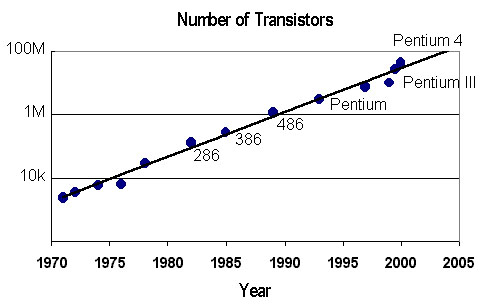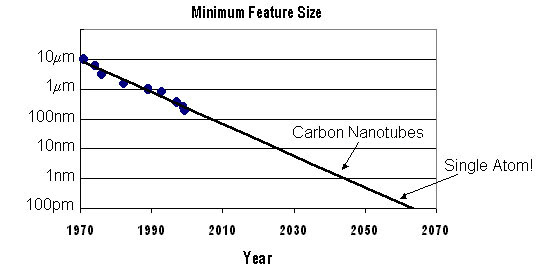Nanotechnology:
A Brief Overview
| MOTIVATION | |
|
In the introduction, I motivated research in nanotechnology by taking a look at nature. Industry forecasters, however, care more about next quarter's returns, and less about the theoretical limits of a given technology. I provide here, therefore, the classic motivation for nanotechnology: Moore's Law.
|
|
| MOORE'S LAW | |
|
In 1965, Gordon Moore made the prediction that the number of transistors on a typical circuit would double every 18-24 months, implying an exponential rise in computer power over time. His 'prediction' was little more than an offhand observation to begin with, but soon it was found to be amazingly accurate, and today is essentially the gospel of the microelectronics industry. It is by assuming that computer power will double every year and a half that the investors are able to justify the enormous sums of money required to build modern microprocessor fabs. Moore's Law, as it is called, drives the industry today.
The graph shows data points for the number of transistors in typical Intel chips over the years (42 million in the Pentium 4 chip), and the straight line is the Moore's Law prediction. Clearly Moore's Law has held for many years now. The question becomes: "How long can we continue?" The problem is that to increase the number of transistors per chip, the transistors must become smaller and smaller. This means that the manufacturing process must be able to define ever-smaller feature sizes year after year.
So far, the industry has kept up with the Moore Law prediction (shown as a black line). The problem, however, is that in the future the demands will be much greater. By 2010, we will need to define 50nm features. By 2040, wire linewidths will be on the order of carbon nanotubes, and by 2060, features will be the size of individual atoms. It seems physically impossible to continue Moore's Law beyond this single-atom barrier, and in fact other physical constraints will likely block the progress much sooner. Moreover, many analysts predict that it will not be physical barriers which cause Moore's prediction to collapse, but rather economic ones. Modern fabs cost billions to build and run, mostly due to the stringent clean-room conditions required (a single speck of dust can ruin your whole chip when your features are only 100nm across), and the cost of fabs increases geometrically, as does computer power. Thus, we may soon reach a point where even the wealthiest banks in the world cannot finance the construction of the fabs. The purpose of presenting Moore's Law (and its limitations) is not to scare the reader (or investors) into believing that the computer industry will cataclysmically collapse in the near future, but rather to point out that our current way of doing things cannot continue forever. It is not that computers cannot get more powerful than the preceding predictions (again, take a look at the human brain if you worry that a 1kg-sized computer cannot be more powerful than modern supercomputers), it is just that the industry will have to adapt to new technologies in order to create future-generation computers. In the short term, this means adopting new micro- and nano-fabrication techniques, to build conventional transistors ever smaller. In the long term, this means adopting entirely new fabrication techniques, which, for instance, circumvent current cleanroom requirements, or which exploit clever computer processing paradigms. In either case, more research in Nanotechnology is key.
|
|
|
|
|

